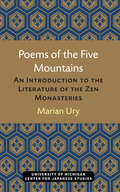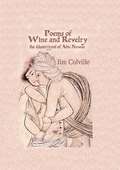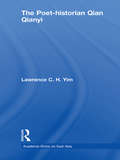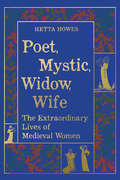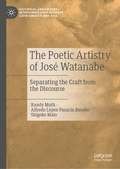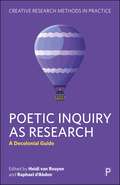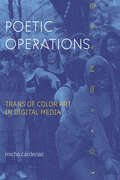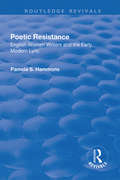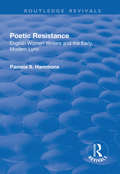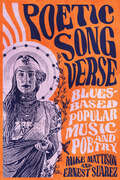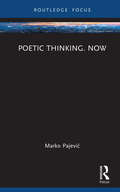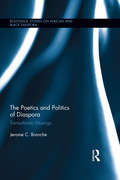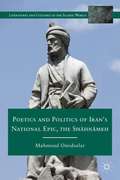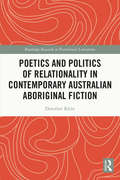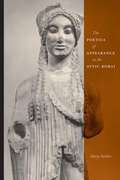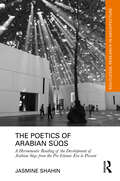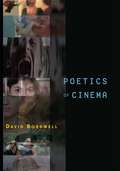- Table View
- List View
Poems of the Five Mountains: An Introduction to the Literature of the Zen Monasteries (Michigan Monograph Series in Japanese Studies #10)
by Marian UryThis second, revised edition of a pioneering volume, long out of print, presents translations of Japanese Zen poems on sorrow, old age, homesickness, the seasons, the ravages of time, solitude, the scenic beauty of the landscape of Japan, and monastic life. Composed by Japanese Zen monks who lived from the last quarter of the thirteenth century to the middle of the fifteenth century, these poems represent a portion of the best of the writing called in Japanese gozan bungaku, “literature of the five mountains.” “Five mountains” or “five monasteries” refers to the system by which the Zen monasteries were hierarchically ordered and governed. For the monks in the monasteries, poetry functioned as a means not only of expressing religious convictions and personal feelings but also of communicating with others in a civilized and courteous fashion. Effacing barriers of time and space, the practice of Chinese poetry also made it possible for Japanese authors to feel at one with their Chinese counterparts and the great poets of antiquity. This was a time when Zen as an institution was being established and contact with the Chinese mainland becoming increasingly frequent—ten of the sixteen poets represented here visited China. Marian Ury has provided a short but substantial introduction to the Chinese poetry of Japanese gozan monasteries, and her translations of the poetry are masterful. Poems of the Five Mountains is an important work for anyone interested in Japanese literature, Chinese literature, East Asian Religion, and Zen Buddhism.
Poems Of Wine & Revelry
by ColvilleFirst published in 2005. Routledge is an imprint of Taylor & Francis, an informa company.
The Poet and the Silk Girl: A Memoir of Love, Imprisonment, and Protest
by Satsuki InaA compelling and prismatic love story of one family's defiance in the face of injustice—and how their story echoes across generations."It is both overwhelming and affirming to imagine, in the midst of their darkest hours, and in the middle of a country and a war that willfully misperceived them as enemy aliens, that the future, for Itaru and Shizuko Ina, was not only possible, but would deliver redemption in the form of the intimate, inexhaustible attention of a daughter." —Brandon Shimoda, author of The Grave on the WallIn 1942 newlyweds Itaru and Shizuko Ina were settling into married life when the United States government upended their world. They were forcibly removed from their home and incarcerated in wartime American concentration camps solely on account of their Japanese ancestry. When the Inas, under duress, renounced their American citizenship, the War Department branded them enemy aliens and scattered their family across the U.S. interior. Born to Itaru and Shizuko during their imprisonment, psychotherapist and activist Satsuki Ina weaves their story together in this moving mosaic. Through diary entries, photographs, clandestine letters, and heart-wrenching haiku, she reveals how this intrepid young couple navigated life, love, loss, and loyalty tests in the welter of World War II-era hysteria.The Poet and the Silk Girl illustrates through one family's saga the generational struggle of Japanese Americans who resisted racist oppression, fought for the restoration of their rights, and clung to their full humanity in the face of adversity. With psychological insight, Ina excavates the unmentionable, recovering a chronicle of resilience amidst one of the severest blows to American civil liberties. As she traces the legacies of trauma, she connects her family's ordeal to modern-day mass incarceration at the U.S.-Mexico border. Lyrical and gripping, this cautionary tale implores us to prevent the repetition of atrocity, pairing healing and protest with galvanizing power.
The Poet-historian Qian Qianyi (Academia Sinica on East Asia)
by Lawrence C.H YimThis book is the first English language study of Qian Qianyi (1582-1664) - a poet and literary critic during the Ming-Qing dynastic transition. Although Qian’s works constitute some of the greatest achievements in pre-modern Chinese lyric poetry, they have been largely understudied and are poorly understood. Qian was reputed for his own aesthetic that changed the character of late Ming and early Qing poetry. His name, however, was branded with infamy for his disloyalty to the Ming dynasty when it dissolved. Consequently, his works were censored by the Qing court and have been forgotten by most critics until recently. Lawrence C.H Yim focuses on Qian’s poetic theory and practice, providing a critical study of Qian’s theory of poetic-history (shishi) and a group of poems from the Toubi ji. He also examines the role played by history in early Qing verse, rethinking the nature of loyalism and historical memory in seventeenth-century China. Poetry of the Ming-Qing transition is distinguished by its manifest historical consciousness and the effort and give meaning to current historical events, an effort characterized by the pathos of introspection and mourning for the past..This pathos translates into what can be called a poetics of Ming loyalism, exemplified and championed by, intriguingly, the later works of Qian Qianyi himself.
Poet, Mystic, Widow, Wife: The Extraordinary Lives of Medieval Women
by Hetta HowesAn invaluable reassessment of what we think we know about the daily lives of women in medieval Europe. Poet, Mystic, Widow, Wife charts the lives and times of four medieval women writers—Marie de France, a poet; Julian of Norwich, a mystic and anchoress; Christine de Pizan, a widow and court writer; and Margery Kempe, a no-good wife—who all bucked convention and forged their own paths. Largely forgotten by modern readers, these women have an astonishing amount to teach us about love, marriage, motherhood, friendship, and earning a living. Reading the words of these four writers, Hetta Howes engagingly reveals how everyday women lived, survived, and thrived in medieval times. Who did they marry and why? Did they ever have extramarital affairs? Could they earn money and become self-sufficient? Could they be leaders? What did they think about death—and what about life and their place in it? Poet, Mystic, Widow, Wife paints a vibrant portrait of these women, their world, and the ways they speak to us today.
The Poethical Wager
by Joan RetallackIn these inventive essays, Joan Retallack conveys her unique post-utopian vision as she explores the relationship between art and life in today's chaotic world. In the tradition of the essay as complex humanist exploration, she engages ideas from across history: Aristotle's definition of happiness, Epicurus's swerve into unpredictable possibility, Montaigne's essays as an instrument of self-invention, John Cage's redefinition of Silence.
The Poetic Artistry of José Watanabe: Separating the Craft from the Discourse (Historical and Cultural Interconnections between Latin America and Asia)
by Randy Muth Alfredo López-Pasarín Basabe Shigeko MatoConnecting multiple academic areas, this book addresses three aspects of the poetry of José Watanabe: 1) the construction of "Japaneseness" in the poetic works and public figure of the poet, 2) the skillful manipulation of literary devices characteristic of his poetry, 3) the unique sensibilities and moods of ephemerality and ineffableness prevalent in his poetic works. The trans/interdisciplinary nature of the book intends to promote a dialogue and exchange of ideas across academic fields neglected in most studies on the Peruvian poet. Written by researchers based in Japan, it offers a unique perspective of Japanese cultural phenomenon unavailable in previous studies. The goal of the book is to shed light on how Japan continues to be seen by the West through essentialist notions and stereotypical representations, as well as to highlight the fact that the literary quality of Watanabe’s poetic artistry does not reside in it being “Japanese” and can be appreciated without resorting to essentialist categorizations based on positive Japanese stereotypes.
Poetic Inquiry: Craft, Method and Practice (Developing Qualitative Inquiry)
by Sandra L. FaulknerPoetic Inquiry: Craft, Method and Practice examines the use of poetry as a form of qualitative research, representation, and method used by researchers, practitioners, and students from across the social sciences and humanities. It serves as a practical manual for using poetry in qualitative research through the presentation of varied examples of Poetic Inquiry. It provides how-to exercises for developing and using poetry as a qualitative research method. The book begins by mapping out what doing and critiquing Poetic Inquiry entails via a discussion of the power of poetry, poets’, and researchers’ goals for the use of poetry, and the kinds of projects that are best suited for Poetic Inquiry. It also provides descriptions of the process and craft of creating Poetic Inquiry, and suggestions for how to evaluate and engage with Poetic Inquiry. The book further contends with questions of method, process, and craft from poets’ and researchers’ perspectives. It shows the implications for the aesthetic and epistemic concerns in poetry, and furthers transdisciplinary dialogues between the humanities and social sciences. Faulkner shows the importance of considering the form and function of Poetic Inquiry in qualitative research through discussions of poetry as research method, poetry as qualitative analysis and representation, and Poetic Inquiry as a powerful research tool.
Poetic Inquiry as Research: A Decolonial Guide (Creative Research Methods in Practice)
by Heidi van Rooyen and Raphael d’AbdonPoetic inquiry is an arts-based approach integrating the humanities and sciences to enhance the quality of social science research and its dissemination. This insightful guide sheds light on the transformative power of poetic inquiry in academic research. Blending poetry with scholarly work, it offers practical advice on crafting research poems, distinguishing them from literary poems and determining when and how to incorporate them into your studies. The book: - helps researchers to explore and express their research creatively; - emphasises diverse and decolonial viewpoints and paths to knowledge; - features methods, case studies, prompts and exercises from the Global South and North. Perfect for researchers eager to explore new dimensions of expression, this guide enriches all aspects of the research process.
Poetic Operations: Trans of Color Art in Digital Media (ASTERISK)
by micha cárdenasIn Poetic Operations artist and theorist micha cárdenas considers contemporary digital media, artwork, and poetry in order to articulate trans of color strategies for safety and survival. Drawing on decolonial theory, women of color feminism, media theory, and queer of color critique, cárdenas develops a method she calls algorithmic analysis. Understanding algorithms as sets of instructions designed to perform specific tasks (like a recipe), she breaks them into their component parts, called operations. By focusing on these operations, cárdenas identifies how trans and gender-non-conforming artists, especially artists of color, rewrite algorithms to counter violence and develop strategies for liberation. In her analyses of Giuseppe Campuzano's holographic art, Esdras Parra's and Kai Cheng Thom's poetry, Mattie Brice's digital games, Janelle Monáe's music videos, and her own artistic practice, cárdenas shows how algorithmic analysis provides new modes of understanding the complex processes of identity and oppression and the intersection of gender, sexuality, and race.
Poetic Resistance: English Women Writers and the Early Modern Lyric (Women And Gender In The Early Modern World Ser.)
by Pamela HammonsThis title was first published in 2002: Pamela Hammons' study contributes to the booming field of early modern women writers by contextualizing and analyzing a unique configuration of underexamined women's texts. By examining how 17th-century English women's composition of lyrics intersects significantly with the social experiences of the writers, the book challenges assumptions that have limited the study of early modern women's writing and reveals the power of lyrics in women's reconceiving or changing of their positions in society. Here Hammons reconsiders how generic conventions were employed as a means by which women writers could borrow from socially sanctioned poetic traditions to express potentially subversive views of their social roles as mothers, religious leaders, widows, and poets. Although the narrative concentrates on early modern lyrics, it also treats contemporary plays, epics, prose polemics, conversion narratives, religious treatises, newsbook articles, and Biblical texts in building its arguments. The study engages extensively with issues concerning manuscript and social texts in the context of print culture through the close examination of a variety of textual practices.
Poetic Resistance: English Women Writers and the Early Modern Lyric (Routledge Revivals)
by Pamela S HammonsThis title was first published in 2002: Pamela Hammons' study contributes to the booming field of early modern women writers by contextualizing and analyzing a unique configuration of underexamined women's texts. By examining how 17th-century English women's composition of lyrics intersects significantly with the social experiences of the writers, the book challenges assumptions that have limited the study of early modern women's writing and reveals the power of lyrics in women's reconceiving or changing of their positions in society. Here Hammons reconsiders how generic conventions were employed as a means by which women writers could borrow from socially sanctioned poetic traditions to express potentially subversive views of their social roles as mothers, religious leaders, widows, and poets. Although the narrative concentrates on early modern lyrics, it also treats contemporary plays, epics, prose polemics, conversion narratives, religious treatises, newsbook articles, and Biblical texts in building its arguments. The study engages extensively with issues concerning manuscript and social texts in the context of print culture through the close examination of a variety of textual practices. It provides a thorough yet subtle grounding in recent feminist criticism, the social history of the family, and the history of authorship practices.
Poetic Song Verse: Blues-Based Popular Music and Poetry
by Mike Mattison Ernest SuarezPoetic Song Verse: Blues-Based Popular Music and Poetry invokes and critiques the relationship between blues-based popular music and poetry in the twentieth and twenty-first centuries. The volume is anchored in music from the 1960s, when a concentration of artists transformed modes of popular music from entertainment to art-that-entertains. Musician Mike Mattison and literary historian Ernest Suarez synthesize a wide range of writing about blues and rock—biographies, histories, articles in popular magazines, personal reminiscences, and a selective smattering of academic studies—to examine the development of a relatively new literary genre dubbed by the authors as “poetic song verse.” They argue that poetic song verse was nurtured in the fifties and early sixties by the blues and in Beat coffee houses, and matured in the mid-to-late sixties in the art of Bob Dylan, the Beatles, the Rolling Stones, the Doors, Jimi Hendrix, Joni Mitchell, Leonard Cohen, Gil Scott-Heron, Van Morrison, and others who used voice, instrumentation, arrangement, and production to foreground semantically textured, often allusive, and evocative lyrics that resembled and engaged poetry. Among the questions asked in Poetic Song Verse are: What, exactly, is this new genre? What were its origins? And how has it developed? How do we study and assess it? To answer these questions, Mattison and Suarez engage in an extended discussion of the roots of the relationship between blues-based music and poetry and address how it developed into a distinct literary genre. Unlocking the combination of richly textured lyrics wedded to recorded music reveals a dynamism at the core of poetic song verse that can often go unrealized in what often has been considered merely popular entertainment. This volume balances historical details and analysis of particular songs with accessibility to create a lively, intelligent, and cohesive narrative that provides scholars, teachers, students, music influencers, and devoted fans with an overarching perspective on the poetic power and blues roots of this new literary genre.
Poetic Thinking. Now (Routledge Focus on Literature)
by Marko PajevićThis book presents my concept of poetic thinking in the context of debates around the anthropological question, that is ‘what is being human?’, building on ‘thinking language’ and dialogical thinking, developing a poetological anthropology. It evokes political and social issues to demonstrate why poetics is of general relevance for our times. The chapters relate these questions to insights of quantum physics and neurosciences and discuss aspects of contemporary technology, media and medicine, employing notions such as atmospheres, immanent transcendence, silence and presence from contemporary thinkers. Poetic thinking considers the world in its togetherness, offering an alternative to the opposition of subject and object. It demonstrates the transformative power in the interaction of the form of language and the form of life. Poetic thinking takes place when a subject constitutes itself in creative and dialogical language, transforming its ways of feeling and thinking, in short, its way of perceiving the world.
Poetic Trespass
by Lital LevyA Palestinian-Israeli poet declares a new state whose language, "Homelandic," is a combination of Arabic and Hebrew. A Jewish-Israeli author imagines a "language plague" that infects young Hebrew speakers with old world accents, and sends the narrator in search of his Arabic heritage. In Poetic Trespass, Lital Levy brings together such startling visions to offer the first in-depth study of the relationship between Hebrew and Arabic in the literature and culture of Israel/Palestine. More than that, she presents a captivating portrait of the literary imagination's power to transgress political boundaries and transform ideas about language and belonging. Blending history and literature, Poetic Trespass traces the interwoven life of Arabic and Hebrew in Israel/Palestine from the turn of the twentieth century to the present, exposing the two languages' intimate entanglements in contemporary works of prose, poetry, film, and visual art by both Palestinian and Jewish citizens of Israel. In a context where intense political and social pressures work to identify Jews with Hebrew and Palestinians with Arabic, Levy finds writers who have boldly crossed over this divide to create literature in the language of their "other," as well as writers who bring the two languages into dialogue to rewrite them from within. Exploring such acts of poetic trespass, Levy introduces new readings of canonical and lesser-known authors, including Emile Habiby, Hayyim Nahman Bialik, Anton Shammas, Saul Tchernichowsky, Samir Naqqash, Ronit Matalon, Salman Masalha, A. B. Yehoshua, and Almog Behar. By revealing uncommon visions of what it means to write in Arabic and Hebrew, Poetic Trespass will change the way we understand literature and culture in the shadow of the Israeli-Palestinian conflict.Some images inside the book are unavailable due to digital copyright restrictions.
The Poetics and Politics of Diaspora: Transatlantic Musings (Routledge Studies on African and Black Diaspora #7)
by Jerome C. BrancheThis book studies the creative discourse of the modern African diaspora by analyzing poems, novels, essays, hip-hop and dub poetry in the Caribbean, England, Spain, and Colombia, and capturing diasporan movement through mutually intersecting axes of dislocation and relocation, and efforts at political group affirmation and settlement, or “location.” Branche’s study connects London’s multimillion-dollar riots of 2011, and its antecedents associated with the West Indian settler community, to the discontent and harrowing conditions facing black immigrants to contemporary Spain as gateway to Fortress Europe. It links the brutal massacres that target Colombia’s dispossessed and displaced poor - and mainly black - “throwaway” citizens, victims of the drug trade and neoliberal expansionism, to older Caribbean stories that tell of the original spurts of capitalist greed, and the colonial cauldron it created, at the center of which lay the slave trade. In revisiting the question of what really has awaited Afro-descendants at the end of the Middle Passage, this volume brings transatlantic slavery, the making of weak postcolonial states that bleed people, and the needle’s eye of racial identification together through a close reading of rappers, black radicals, dub poetry, and novelists from Europe, Africa, and the Americas. Branche at once demonstrates the existence of an archive of Afro-modern diasporan, discursive production, and just as importantly, points toward a historically-rooted theoretical framework that would contain its liberatory trajectory.
Poetics and Politics of Iran’s National Epic, the Shāhnāmeh
by Mahmoud OmidsalarThis book considers some of the Western interpretations of The Shahnameh - Iran's national epic, and argues that these interpretations are not only methodologically flawed, but are also more revealing of Western concerns and anxieties about Iran than they are about the Shahnameh.
Poetics and Politics of Relationality in Contemporary Australian Aboriginal Fiction (Routledge Research in Postcolonial Literatures)
by Dorothee KleinPoetics and Politics of Relationality in Contemporary Australian Aboriginal Fiction is the first sustained study of the formal particularities of works by Bruce Pascoe, Kim Scott, Tara June Winch, and Alexis Wright. Drawing on a rich theoretical framework that includes approaches to relationality by Aboriginal thinkers, Edouard Glissant, and Jean-Luc Nancy, and recent work in New Formalism and narrative theory, it illustrates how they use a broad range of narrative techniques to mediate, negotiate, and temporarily create networks of relations that interlink all elements of the universe. Through this focus on relationality, Aboriginal writing gains both local and global significance. Locally, these narratives assert Indigenous sovereignty by staging an unbroken interrelatedness of people and their Land. Globally, they intervene into current discourses about humanity’s relationship with the natural environment, urging readers to acknowledge our interrelatedness with and dependence on the land that sustains us.
The Poetics and Politics of Youth in Milton's England
by Blaine GretemanAs the notion of government by consent took hold in early modern England, many authors used childhood and maturity to address contentious questions of political representation - about who has a voice and who can speak on his or her own behalf. For John Milton, Ben Jonson, William Prynne, Thomas Hobbes, and others, the period between infancy and adulthood became a site of intense scrutiny, especially as they examined the role of a literary education in turning children into political actors. Drawing on new archival evidence, Blaine Greteman argues that coming of age in the seventeenth century was a uniquely political act. His study makes a compelling case for understanding childhood as a decisive factor in debates over consent, autonomy, and political voice, and will offer graduate students and scholars a new perspective on the emergence of apolitical children's literature in the eighteenth century.
The Poetics of American Song Lyrics (American Made Music Series)
by Charlotte PenceThe Poetics of American Song Lyrics is the first collection of academic essays that regards songs as literature and that identifies intersections between the literary histories of poems and songs. The essays by well-known poets and scholars including Pulitzer Prize winner Claudia Emerson, Peter Guralnick, Adam Bradley, David Kirby, Kevin Young, and many others, locate points of synthesis and separation so as to better understand both genres and their crafts. The essayists share a desire to write on lyrics in a way that moves beyond sociological, historical, and autobiographical approaches and explicates songs in relation to poetics. Unique to this volume, the essays focus not on a single genre but on folk, rap, hip hop, country, rock, indie, soul, and blues. The first section of the book provides a variety of perspectives on the poetic history and techniques within songs and poems, and the second section focuses on a few prominent American songwriters such as Bob Dylan, Bruce Springsteen, and Michael Stipe. Through conversational yet in-depth analyses of songs, the essays discuss sonnet forms, dramatic monologues, Modernism, ballads, blues poems, confessionalism, Language poetry, Keatsian odes, unreliable narrators, personas, poetic sequences, rhythm, rhyme, transcription methods, the writing process, and more. While the strategies of explication differ from essay to essay, the nexus of each piece is an unveiling of the poetic history and poetic techniques within songs.
The Poetics of Ancient and Classical Arabic Literature: Orientology (Culture and Civilization in the Middle East)
by Esad DurakovicThrough analysing ancient and classical Arabic literature, including the Qur'an, from within the Arabic literary tradition, this book provides an original interpretation of poetics, and of other important aspects of Arab culture. <P><P> Ancient Arabic literature is a realm of poetry; prose literary forms emerged rather late, and even then remained in the shadow of poetic creative efforts. Traditionally, this literature has been viewed through a philologist’s lens and has often been represented as ‘materialistic’ in the sense that its poetry lacked imagination. As a result, Arabic poetry was often evaluated negatively in relation to other poetic traditions. The Poetics of Ancient and Classical Arabic Literature argues that old Arabic literature is remarkably coherent in poetical terms and has its own individuality, and that claims of its materialism arise from a failure to grasp the poetic principles of the Arabic tradition. Analysing the Qur’an, which is known for confronting the poetry of the time, this book reveals that "post Qur’anic" literature came to be defined against it. Thus, the constitution and interpretation of Arabic literature imposed itself as a particular exegesis of the sacred Text. <P><P> Disputing traditional interpretations by arguing that Arabic literature can only be assessed from within, and not through comparison with other literary traditions, this book is of interest to students and scholars of Islamic Studies, Arabic Studies and Literary Studies.
The Poetics of Appearance in the Attic Korai
by Mary StieberSome of the loveliest works of Archaic art were the Athenian korai--sculptures of beautiful young women presenting offerings to the goddess Athena that stood on the Acropolis. Sculpted in the sixth and early fifth centuries B. C. , they served as votives until Persians sacked the citadel in 480/79 B. C. Subsequently, they were buried as a group and forgotten for nearly twenty-four centuries, until archaeologists excavated them in the 1880s. Today, they are among the treasures of the Acropolis Museum. Mary Stieber takes a fresh look at the Attic korai in this book. Challenging the longstanding view that the sculptures are generic female images, she persuasively argues that they are instead highly individualized, mimetically realistic representations of Archaic young women, perhaps even portraits of real people. Marshalling a wide array of visual and literary evidence to support her claims, she shows that while the korai lack the naturalism that characterizes later Classical art, they display a wealth and realism of detail that makes it impossible to view them as generic, idealized images. This iconoclastic interpretation of the Attic korai adds a new dimension to our understanding of Archaic art and to the distinction between realism and naturalism in the art of all periods. Some of the loveliest works of Archaic art were the Athenian korai--sculptures of beautiful young women presenting offerings to the goddess Athena that stood on the Acropolis. Sculpted in the sixth and early fifth centuries B. C. , they served as votives until Persians sacked the citadel in 480/79 B. C. Subsequently, they were buried as a group and forgotten for nearly twenty-four centuries, until archaeologists excavated them in the 1880s. Today, they are among the treasures of the Acropolis Museum. Mary Stieber takes a fresh look at the Attic korai in this book. Challenging the longstanding view that the sculptures are generic female images, she persuasively argues that they are instead highly individualized, mimetically realistic representations of Archaic young women, perhaps even portraits of real people. Marshalling a wide array of visual and literary evidence to support her claims, she shows that while the korai lack the naturalism that characterizes later Classical art, they display a wealth and realism of detail that makes it impossible to view them as generic, idealized images. This iconoclastic interpretation of the Attic korai adds a new dimension to our understanding of Archaic art and to the distinction between realism and naturalism in the art of all periods.
The Poetics of Arabian Sūqs: A Hermeneutic Reading of the Development of Arabian Sūqs from the Pre-Islamic Era to Present (Routledge Research in Architecture)
by Jasmine ShahinThis book investigates the history of Arabian sūqs from their pre-Islamic beginnings to the present. Collecting evidence from archaeological ruins, Islamic towns, modern cities, Arabic poetry, philosophical debates, political conflicts, puppet shows and the insights of modern-day market-goers, the book presents new and unforeseen interpretations of the Arabian sūq’s meaning and its transformation through time and place. The finding that such meaning is tied to ancient trade rituals, where temple and market presented a holistic socio-urban unit, re-questions some instrumental assumptions regarding the value of sūq-ness in Arabia’s everyday practices. Such a finding, which locates the fadaā/tareeq duality as a central theme in Arabia’s socio-urban discourse, emphasizes the importance of lived experiences and poetics as key sources for understanding socio-urban phenomena.
Poetics of Cinema
by David BordwellBringing together twenty-five years of work on what he has called the "historical poetics of cinema," David Bordwell presents an extended analysis of a key question for film studies: how are films made, in particular historical contexts, in order to achieve certain effects? For Bordwell, films are made things, existing within historical contexts, and aim to create determinate effects. Beginning with this central thesis, Bordwell works out a full understanding of how films channel and recast cultural influences for their cinematic purposes. With more than five hundred film stills, Poetics of Cinema is a must-have for any student of cinema.
Poetics of Cinema
by David BordwellBringing together twenty-five years of work on what he has called the "historical poetics of cinema," David Bordwell presents an extended analysis of a key question for film studies: how are films made, in particular historical contexts, in order to achieve certain effects? For Bordwell, films are made things, existing within historical contexts, and aim to create determinate effects. Beginning with this central thesis, Bordwell works out a full understanding of how films channel and recast cultural influences for their cinematic purposes. With more than five hundred film stills, Poetics of Cinema is a must-have for any student of cinema.
